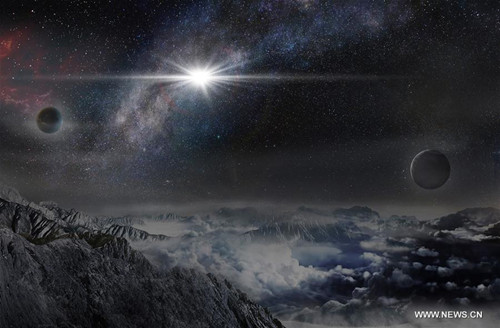
This picture made by Ma Jin from Beijing Planetarium shows an artist's impression of the record-breakingly powerful, super luminous supernova ASASSN-15lh as it would appear from an exoplanet located about 10,000 light years away in the host galaxy of the supernova. An international team of astronomers, led by Subo Dong from China's Peking University, said Thursday they have spotted a violent stellar explosion, known as a supernova, that is about 200 times more powerful than a typical supernova and more than twice as luminous as the previous record holder. At its peak intensity, the explosion, called ASASSN-15lh, shone brighter than 570 billion Suns. (Photo/Xinhua)
An international team of astronomers, led by Subo Dong from China's Peking University, said Thursday they have spotted a violent stellar explosion, known as a supernova, that is about 200 times more powerful than a typical supernova and more than twice as luminous as the previous record holder.
At its peak intensity, the explosion, called ASASSN-15lh, shone brighter than 570 billion Suns.
The record-breaking blast, reported Thursday in the U.S. journal Science, is thought to be an outstanding example of a "superluminous supernova," or a recently discovered, supremely rare variety of explosion unleashed by certain stars when they die.
Scientists are frankly at a loss, though, regarding what sorts of stars and stellar scenarios might be responsible for these extreme supernovae.
"ASASSN-15lh is the most powerful supernova discovered in human history," said the study lead author Dong, an astronomer and a Youth Qianren Research Professor at the Kavli Institute for Astronomy and Astrophysics (KIAA) at Peking University. "The explosion's mechanism and power source remain shrouded in mystery because all known theories meet serious challenges in explaining the immense amount of energy ASASSN-15lh has radiated."
About 3.8 billion light years from Earth, ASASSN-15lh was first glimpsed in June 2015 by the All Sky Automated Survey for SuperNovae (ASAS-SN) team, an international collaboration headquartered at the Ohio State University, which uses a network of 14-centimeter telescopes around the world to scan the visible sky every two or three nights looking for very bright supernovae.
Further observations revealed that ASASSN-15lh bears certain features consistent with "hydrogen-poor" (Type I) superluminous supernovae, which are one of the two main types of these epic explosions so named for lacking signatures of the chemical element hydrogen in their spectra.
Yet in other ways, besides its brute power, ASASSN-15lh stands apart. It is way hotter, and not just brighter, than its apparently nearest of supernova kin, they said.
The galaxy it calls home is also without precedent. Type I superluminous supernovae seen to date have all burst forth in dim galaxies both smaller in size and that churn out stars much faster than the Milky Way, but ASASSN-15lh's galaxy appears even bigger and brighter than the Milky Way.
The researchers also speculated that the extraordinary emission of luminosity by ASASSN-15lh may be powered by a staggering amount of decaying radioactive nickel, or perhaps a rapidly rotating, highly magnetic neutron star.
"The honest answer is at this point that we do not know what could be the power source for ASASSN-15lh," said Dong. "ASASSN-15lh may lead to new thinking and new observations of the whole class of superluminous supernova, and we look forward to plenty more of both in the years ahead."


















































